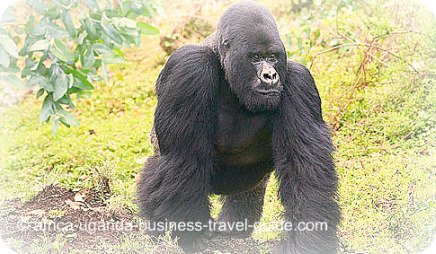BWINDI IMPENETRABLE NATIONAL PARK
When planning a Gorilla tracking Safari, consider Bwindi Impenetrable National Park before you look else where.
The obvious rationale for your decision is that by making this one Gorilla safari to Bwindi, you will be in contact with almost half the world's mountain gorilla population.

Furthermore, you can make a cocktail of other guided walks through the forest, including:
- walks to a waterfall,
- walks for monkey watching, and
- Walks for birding.
You can visit the park any time throughout the year, although conditions in the park are more difficult during the rainy season.
On this page we share with you some of the most important information you need to know about this Uganda National park before making your final vacation plans.
You will find info about
- Where to find Bwindi
- Gorilla tracking in Bwindi,
- Other attractions within Bwindi Forest National park, and
- Where to stay
Where to find Bwindi Impenetrable National Park?
Bwindi Impenetrable National Park is located in southwestern part of Uganda.
It covers an area of 331 square kilometers. Western side of the park is the border to DRC while Kabale town is to its southeast & it is the nearest main town to the park, 29 km away by road.
| Caution
Bwindi National Park is in a remote location, and reaching the park involves a long difficult journey and the roads are in a bad condition. |
The park comprises two blocks of forest that are connected by a small corridor of forest.
The shape of the park is unique & it gives credit to the previous conservation management, which protected the original two forest blocks in 1932. There is agricultural land where there were previously trees directly outside the park's borders.
The park is located at the edge of the Western Rift Valley in the highest parts of the Kigezi Highlands which were created by up-warping of the Western Rift Valley.
Bwindi's topography is very rugged, with narrow valleys intersected by rivers and steep hills.
Altitudes in the park range from 1,190 m to 2,607 m above sea level, and 60% of the park has an elevation of over 2,000 meters. The highest elevation in the park is Rwamunyonyi hill at the eastern edge of the park. The lowest part of the park is located at its most northern tip.
The forest is an important water catchment’s area with generally impermeable underlying geology where water mostly flows. Much of the park’s rainfall form a dense network of streams found in the forest.
| Tip Rainfall occurs from March to April and from September to November. Therefore if you were planning to visit the park it may not be very suitable time since conditions in the park are more difficult during rainy season. |
Gorilla Tracking in Bwindi Impenetrable National Park
Gorilla tracking is the park's main tourist attraction. Tourists wishing to track gorillas must first obtain a permit to do so.
Bwindi has a whooping 340 Individual mountain Gorillas, which is half the worlds currently surviving Mountain Climbing Gorillas.
Gorilla tracking generates much revenue for Uganda Wildlife Authority; therefore, strict rules have been instituted for tourists to minimize the risk of diseases passing from them to these Mountain gorillas.
Diseases & habitat loss are the greatest threat to these endangered species.
Uganda, Rwanda, and the Democratic Republic of the Congo are the only countries where it is possible to visit mountain gorillas.
Bwindi Mountain Gorilla Videos
Other attractions within Bwindi Impenetrable Forest National Park
Bwindi Impenetrable Forest is an old complex, biologically rich with diverse species of animals and trees.
It became an UNESCO World Heritage Site because of its ecological importance.
Among East African forests, Bwindi has some of the richest populations of trees, small mammals, birds, butterflies, reptiles, and moths.
The park's diverse species are partly a result of the large variations of altitude and habitat types in the park.
The park has more than 220 tree species (more than 50% of Uganda’s tree species), more than 100 fern species, the Brown Mahogany which is a threatened plant species within the park.
Bwindi is thought to have one of the richest faunal communities in East Africa. There are an estimated 120 mammal species in the park, ten of which are primates, and more than 45 of which are small mammal species.
Apart from the mountain gorillas, other mammal species within the park include:
- The common chimpanzee,
- L'Hoest's monkey,
- white colobus monkey,
- Red-tailed monkeys,
- Vervets,
- African elephant,
- African Green Broadbill,
- Cream-banded Swallowtail
- The giant forest hog, and
- The small antelope species.
The park has over 350 bird species and more than 200 butterfly species.
Bwindi is therefore a one stop shop for most of the African wildlife!
Where to stay in Bwindi Impenetrable National Park?
Available tourist accommodation in Bwindi includes:
- a lodge,
- tented camps,and
- cheaper rooms run by the local community, located near the Buhoma entrance gate.
Click here for more information about tourist accommodation in Bwindi National Park.
Click here for information on how to start your own Tourism business in Uganda.
Home


